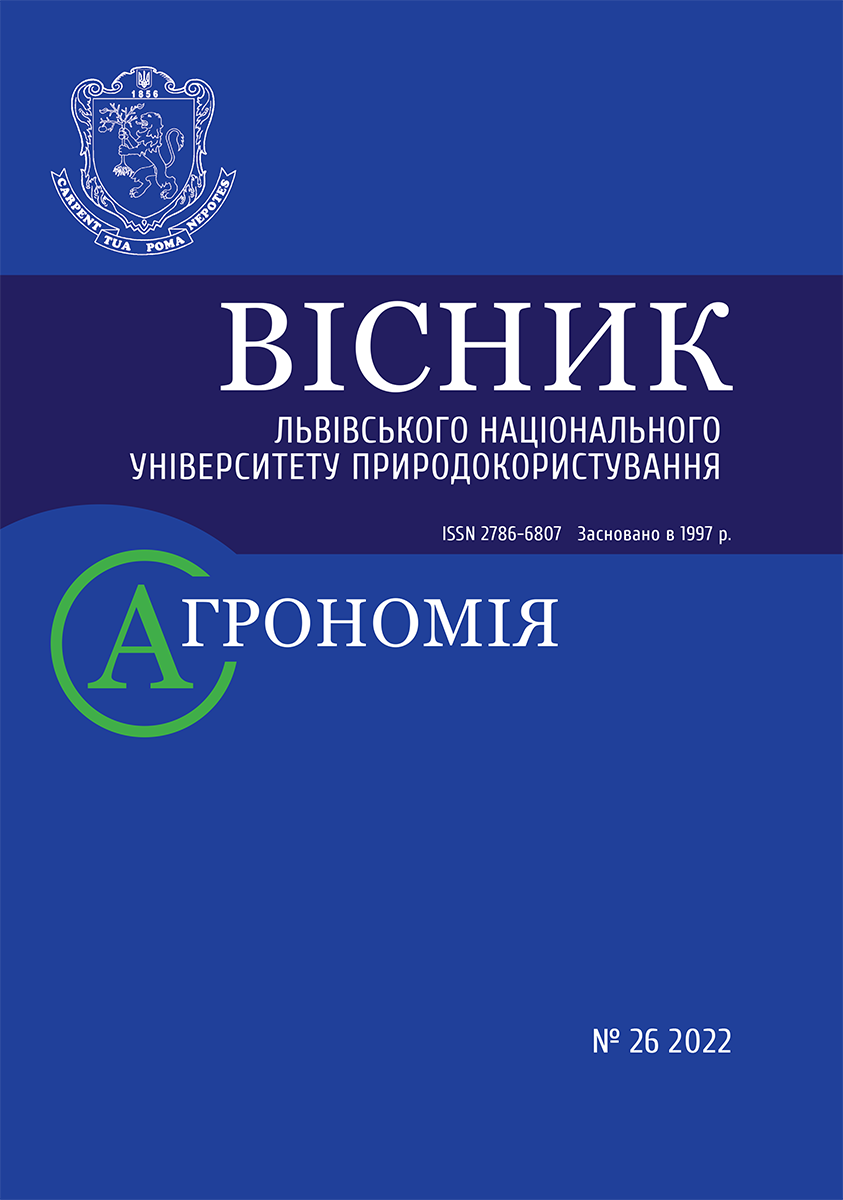THE INFLUENCE OF THE BIOLOGICAL ACTIVATOR NUTRILIFE ON THE YIELD AND QUALITY OF ONIONS
DOI:
https://doi.org/10.31734/agronomy2022.26.087Keywords:
Allium cepa L., biostimulator, dry matter, foliar application, yielding, total sugarsAbstract
Belonging to the Alliaceae family, onion (Allium cepa L.) is one of the most important and popular vegetable and spice crops grown all over the world. Onions are demanding on soil fertility. It is especially demanding to the increased concentration of mineral salts in the soil. At the beginning of the growing season, onion plants must be supplied with nitrogen. A high yield of onions is obtained on light fertile sandy and loamy soils with a pH of 6-7. Correct provision of plants with macro- and microelements can have a beneficial effect on the growth and yield of turnip onions, which is extremely important on poor soils. At the time when environmental protection is becoming an important concern, new friendly methods of stimulating plant growth are being investigated, among others, by applying macroelements, microelements and various growth stimulants to the leaves. One of the new products is Nutrilife, a biological activator. It is a combination of macro- and microelements (EDTA), humic and fulvic acids, enzymes and amino acids. The field experiment was carried out in east-central Poland, 85 km east of Warsaw, on Luvisol soil. The aim of the studies was to determine the effect of Nutrilife applied to leaves during the BBCH 19 stage, with the simultaneous reduction of nitrogen or phosphorus soil doses by half, on the yield and the content of dry matter and sugars in onion. The Nutrilife activator allowed half reducing mineral nitrogen or phosphorus doses, while the yield was the same as in the case of full NPK treatment. The effect of Nutrilife on onion dry matter content was dependent on the weather conditions in the years of research and the applied mineral fertilizer treatment. There was no significant effect of the activator on the total sugar content.
References
Effect of seaweed extract on productivity and quality attributes of four onion cultivars / Abbas M., Anwar J., Zafar-ul-Hye M. et al. Horticulturae. 2020. No 6 (2). P. 28.
EU 2009. Commission Regulation NO 152/2009. Official Journal of the European Union L54. P. 1–130.
EUROSTAT 2021. Agricultural production – crops. URL: https://ec.europa.eu/eurostat/statistics-explained/index.php?title=Agricultural_production_-_crops#Vegetables (Accessed 16 June 2022).
FAOSTAT 2021. Onions production in 2019, Crops/Regions/World list/Production Quantity (pick lists). UN Food and Agriculture Organization, Corporate Statistical Database. URL: http://www.fao.org/faostat/en/#data/QC/visualize (Accessed 26 April 2021).
Francke A., Majkowska-Gadomska J., Kaliniewicz Z., Jadwisieńczak K. No effect of biostimulants on the growth, yield and nutritional value of shallots grown for bunch harvest. Agronomy. 2022. No 12 (5). P. 1156.
Gajc-Wolska K., Kowalczyk K., Nowecka M., Mazur K., Metera A. Effect of organic-mineral fertilizers on the yield and quality of endive (Cichorium endivia L.). Acta Scientiarum Polonorum, Hortorum Cultus. 2012. No11. P. 189–200.
Grabowska A., Kunicki E., Sękar A., Kalisz A., Wojciechowska R. The effect of cultivar and biostimulant treatment on the carrot yield and its quality. Vegetable Crops Research Bulletin. 2012. No 77 (1). P. 37–48.
Grajkowski J., Ochmian I. Influence of three biostymulants on yielding and fruit quality of three primocane raspberry cultivars. Acta Scientiarum Polonorum, Hortorum Cultus. 2007. No 6. P. 29–36.
Hafez E., Geries L. Onion (Allium cepa L.) growth, yield and economic return under different combinations of nitrogen fertilizers and agricultural biostimulants. Cercetari Agronomice in Moldova. 2018. No 5 (3). P. 69–88.
Hidangmayum A., Sharma R. Effect of different concentration of commercial seaweed liquid extract of Ascophylum nodosum on Germination of onion (Allium cepa L.). International Journal of Science and Research. 2017. No 6 (7). P. 1488–1491.
URL: http://www.bio-energy.lt/en/produktai/dirvos-gerinimo-preparatai/nutrilife (Accessed 23 April 2021).
Jardin P. Plant biostimulants: Definition, concept, main categories and regulation. Scientia Horticulturae. 2015. No 196. P. 3–14.
Marschner P. Marschner’s mineral nutrition of higher plants. 3rd edition. London : Elsevier, 2011.
Matysiak K. Technologicznie i interwencyjnie. Wiadomości Rolnicze Polska. 2010. No 66 (3). P. 6.
McKeown A. W., Warland J., McDonald M. R. Long-term climate and weather patterns in relation to crop yield: a minireview. Canadian Journal of Botany. 2006. No 84 (7). P. 1031–1036.
Mikulewicz E., Majkowska-Gadomska J., Jadwisieńczak K., Francke A. Effect of selected biostimulants on the yield and quality of the common onion (Allium cepa L.). Acta Agrophysica. 2019. No 2 (1). P. 57–65.
Physiological, nutritional and metabolomic responses of tomato plants after the foliar application of amino acids aspartic acid, glutamic acid and alanine / Alfosea-Simón M., Simón-Grao S., Zavala-Gonzalez E. A. et.al. Frontiers in Plant Science. 2021. No 11. P. 581.
Rouphael Y., Colla G. Synergistic biostimulatory action: designing the next generation of plant biostimulants for sustainable agriculture. Frontiers in Plant Science. 2018. No 9. P. 1655.
Screening of microalgae liquid extracts for their bio stimulant properties on plant growth, nutrient uptake and metabolite profile of / Mutale-Joan Ch., Redouane B., Najib E. et. al. Solanum lycopersicum L. Scientific Reports. 2020. No 1 (1). P. 2820.
Souri M. K. Plants adaptation to control nitrifcation process in tropical region; case study with Acrocomia totai and Brachiaria humidicola plants. Open Agriculture. 2016. No 1 (1). P. 144–150.
Sulewska H., Kruczek A. Assessment of the stimulating effect of Bio-algeen S 90 on selected species of crops. Selected ecological issues in the modern world. PIMR Poznań, Monograph. 2005. Vol. 2. P. 203–209.
Szczepanek M., Wszelaczyńska E., Pobereż J., Ochmian I. Response of onion (Allium cepa L.) to the method of sea-weed biostimulant application. Acta Scientiarum Polonorum, Hortorum Cultus. 2017. No 16. P. 113–122.
Yakhin O. I., Lubianov A. A., Yakhin I. A., Brown P. H. Biostimulants in plant science: A global perspective. Frontiers in Plant Science. 2017. No 7. P. 2049.


